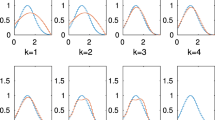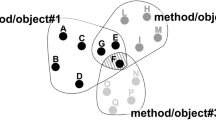Abstract
Frequency-domain electromagnetic instruments allow the collection of data in different configurations, that is, varying the intercoil spacing, the frequency, and the height above the ground. Their handy size makes these tools very practical for near-surface characterization in many fields of applications, for example, precision agriculture, pollution assessments, and shallow geological investigations. To this end, the inversion of either the real (in-phase) or the imaginary (quadrature) component of the signal has already been studied. Furthermore, in many situations, a regularization scheme retrieving smooth solutions is blindly applied, without taking into account the prior available knowledge. The present work discusses an algorithm for the inversion of the complex signal in its entirety, as well as a regularization method that promotes the sparsity of the reconstructed electrical conductivity distribution. This regularization strategy incorporates a minimum gradient support stabilizer into a truncated generalized singular value decomposition scheme. The results of the implementation of this sparsity-enhancing regularization at each step of a damped Gauss–Newton inversion algorithm (based on a nonlinear forward model) are compared with the solutions obtained via a standard smooth stabilizer. An approach for estimating the depth of investigation, that is, the maximum depth that can be investigated by a chosen instrument configuration in a particular experimental setting, is also discussed. The effectiveness and limitations of the whole inversion algorithm are demonstrated on synthetic and real data sets.










Similar content being viewed by others
References
Andrews GE, Askey R, Roy R (1999) Special functions. Encyclopedia of mathematics and its applications, vol 71. Cambridge University Press, Cambridge
Archie G (1942) The electrical resistivity log as an aid in determining some reservoir characteristics. Trans AIME 146(1):54–62
Björck A (1996) Numerical methods for least squares problems. SIAM, Philadelphia
Boaga J, Ghinassi M, D’Alpaos A, Deidda GP, Rodriguez G, Cassiani G (2018) Geophysical investigations unravel the vestiges of ancient meandering channels and their dynamics in tidal landscapes. Sci Rep 8:1708
Christiansen A, Auken E (2012) A global measure for depth of investigation. Geophysics 77(4):WB171–WB177
Deidda GP, Fenu C, Rodriguez G (2014) Regularized solution of a nonlinear problem in electromagnetic sounding. Inverse Probl 30:125014
Deidda GP, Díaz de Alba P, Rodriguez G (2017) Identifying the magnetic permeability in multi-frequency EM data inversion. Electron Trans Numer Anal 47:1–17
Deidda GP, Díaz de Alba P, Rodriguez G, Vignoli G (2018) Smooth and sparse inversion of EMI data from multi-configuration measurements. In: 2018 IEEE 4th international forum on research and technology for society and industry (RTSI 2018). Palermo, Italy, pp 213–218
Deidda GP, Díaz de Alba P, Fenu C, Lovicu G, Rodriguez G (2019) FDEMtools: a MATLAB package for FDEM data inversion. Numer Algorithms. https://doi.org/10.1007/s11075-019-00843-2 (in press)
Díaz de Alba P, Rodriguez G (2016) Regularized inversion of multi-frequency EM data in geophysical applications. In: Ortegón Gallego F, Redondo Neble M, Rodríguez Galván J (eds) Trends in differential equations and applications. SEMA SIMAI Springer Series, vol 8. Springer, Basel, pp 357–369
Dragonetti G, Comegna A, Ajeel A, Deidda GP, Lamaddalena N, Rodriguez G, Vignoli G, Coppola A (2018) Calibrating electromagnetic induction conductivities with time-domain reflectometry measurements. Hydrol Earth Syst Sci 22:1509–1523
Farquharson CG, Oldenburg DW, Routh PS (2003) Simultaneous 1D inversion of loop–loop electromagnetic data for magnetic susceptibility and electrical conductivity. Geophysics 68(6):1857–1869
Fiandaca G, Doetsch J, Vignoli G, Auken E (2015) Generalized focusing of time-lapse changes with applications to direct current and time-domain induced polarization inversions. Geophys J Int 203(2):1101–1112
Guillemoteau J, Simon F, Luck E, Tronicke J (2016) 1D sequential inversion of portable multi-configuration electromagnetic induction data. Near Surf Geophys 14:411–420
Gunning J, Glinsky M, Hedditch J (2010) Resolution and uncertainty in 1D CSEM inversion: a Bayesian approach and open-source implementation. Geophysics 75(6):F151–F171
Haaken K, Deidda GP, Cassiani G, Deiana R, Putti M, Paniconi C, Scudeler C, Kemna A (2017) Flow dynamics in hyper-saline acquifers: hydro-geophysical monitoring and modelling. Hydrol Earth Syst Sc 21:1439–1454
Hansen P (1998) Rank-deficient and discrete Ill-posed problems: numerical aspects of linear inversion. SIAM, Philadelphia
Hochstenbach ME, Reichel L, Rodriguez G (2015) Regularization parameter determination for discrete ill-posed problems. J Comput Appl Math 273:132–149
Horst R, Pardalos PM (2013) Handbook of global optimization. Nonconvex optimization and its applications, vol 2. Springer, Berlin
Huang H, Won IJ (2003) Real-time resistivity sounding using a hand-held broadband electromagnetic sensor. Geophysics 68(4):1224–1231
Kaipio JP, Kolehmainen V, Somersalo E, Vauhkonen M (2000) Statistical inversion and monte carlo sampling methods in electrical impedance tomography. Inverse Probl 16(5):1487
Last BJ, Kubik K (1983) Compact gravity inversion. Geophysics 48(6):713–721
Lesch S, Strauss D, Rhoades J (1995) Spatial prediction of soil salinity using electromagnetic induction techniques: 1. Statistical prediction models: a comparison of multiple linear regression and cokriging. Water Resour Res 31:373–386
Ley-Cooper A, Viezzoli A, Guillemoteau J, Vignoli G, Macnae J, Cox L, Munday T (2015) Airborne electromagnetic modelling options and their consequences in target definition. In: Exploration geophysics 46, special issue: 6th international conference in airborne electromagnetics (AEM 2013), pp 74–84
Martinelli P, Duplaá M (2008) Laterally filtered 1D inversions of small-loop, frequency-domain EMI data from a chemical waste site. Geophysics 73:143–149
Minsley B, Abraham J, Smith B, Cannia J, Voss C, Jorgenson M, Walvoord M, Wylie B, Anderson L, Ball L, Deszcz-Pan M, Wellman T, Ager T (2012) Airborne electromagnetic imaging of discontinuous permafrost. Geophys Res Lett 39(2):L02503
Nabighian M, Macnae J (1989) Time-domain electromagnetic prospecting methods. Electromagn Methods Appl Geohpys Soc Explor Geophys 2:427–520
Oldenburg D, Li Y (1999) Estimating depth of investigation in DC resistivity and IP surveys. Geophysics 64:403–416
Osella A, de la Vega M, Lascano E (2005) 3D electrical imaging of an archaeological site using electrical and electromagnetic methods. Geophysics 70:101–107
Paine J (2003) Determining salinization extent, identifying salinity sources, and estimating chloride mass using surface, borehole, and airborne electromagnetic induction methods. Water Resour Res 39:1059
Park Y, Reichel L, Rodriguez G, Yu X (2018) Parameter determination for Tikhonov regularization problems in general form. J Comput Appl Math 343:12–25
Pellerin L (2002) Applications of electrical and electromagnetic methods for environmental and geotechnical investigations. Surv Geophys 23:101–132
Portniaguine O, Zhdanov M (1999) Focusing geophysical inversion images. Geophysics 64:874–887
Reichel L, Rodriguez G (2013) Old and new parameter choice rules for discrete ill-posed problems. Numer Algorithms 63(1):65–87
Rudin LI, Osher S, Fatemi E (1992) Nonlinear total variation based noise removal algorithms. Physica D 60(1–4):259–268
Vasić D, Ambruš D, Bilas V (2015) Stochastic inversion of two-layer soil model parameters from electromagnetic induction data. In: 2015 IEEE sensors applications symposium (SAS), IEEE, pp 1–5
Vatankhah S, Renaut R, Ardestani V (2017) 3D Projected \({L}_1\) inversion of gravity data using truncated unbiased predictive risk estimator for regularization parameter estimation. Geophys J Int 210:1872–1887
Viezzoli A, Christiansen A, Auken E, Sorensen K (2008) Quasi-3D modeling of airborne TEM data by spatially constrained inversion. Geophysics 73:F105–F113
Viezzoli A, Munday T, Auken E, Christiansen A (2010) Accurate quasi 3D versus practical full 3D inversion of AEM data—the Bookpurnong case study. Preview 149:23–31
Vignoli G, Deiana R, Cassiani G (2012) Focused inversion of vertical radar profile (VRP) travel-time data. Geophysics 77:H9–H18
Vignoli G, Fiandaca G, Christiansen A, Kirkegaard C, Auken E (2015) Sharp spatially constrained inversion with applications to transient electromagnetic data. Geophys Prospect 63:243–255
Vignoli G, Sapia V, Menghini A, Viezzoli A (2017) Examples of improved inversion of different airborne electromagnetic datasets via sharp regularization. J Environ Eng Geophys 22:51–61
Wait J (1982) Geo-electromagnetism. Academic Press, New York
Wei Z, Zhang J, Xu Z, Huang Y, Liu Y, Fan X (2018) Gradient projection with approximate \(L_0\) norm minimization for sparse reconstruction in compressed sensing. Sensors 18(10):3373
Yao R, Yang J (2010) Quantitative evaluation of soil salinity and its spatial distribution using electromagnetic induction method. Agric Water Manage 97:1961–1970
Zhdanov M (2002) Geophysical inverse theory and regularization problems. Elsevier, Amsterdam
Zhdanov M, Vignoli G, Ueda T (2006) Sharp boundary inversion in crosswell travel-time tomography. J Geophys Eng 3:122–134
Acknowledgements
The authors wish to thank the reviewers for their comments, which led to improvements in the presentation. This research was supported in part by the Fondazione di Sardegna 2017 research project “Algorithms for Approximation with Applications [Acube]”, the INdAM-GNCS research project “Metodi numerici per problemi mal posti”, the INdAM-GNCS research project “Discretizzazione di misure, approssimazione di operatori integrali ed applicazioni”, the Regione Autonoma della Sardegna research project “Algorithms and Models for Imaging Science [AMIS]” (RASSR57257, intervento finanziato con risorse FSC 2014-2020 - Patto per lo Sviluppo della Regione Sardegna), the Visiting Scientist Programme 2015/2016 (University of Cagliari), and an RAS/FBS Grant (Grant No. F71/17000190002).
Author information
Authors and Affiliations
Corresponding author
Rights and permissions
About this article
Cite this article
Deidda, G.P., Díaz de Alba, P., Rodriguez, G. et al. Inversion of Multiconfiguration Complex EMI Data with Minimum Gradient Support Regularization: A Case Study. Math Geosci 52, 945–970 (2020). https://doi.org/10.1007/s11004-020-09855-4
Received:
Accepted:
Published:
Issue Date:
DOI: https://doi.org/10.1007/s11004-020-09855-4




